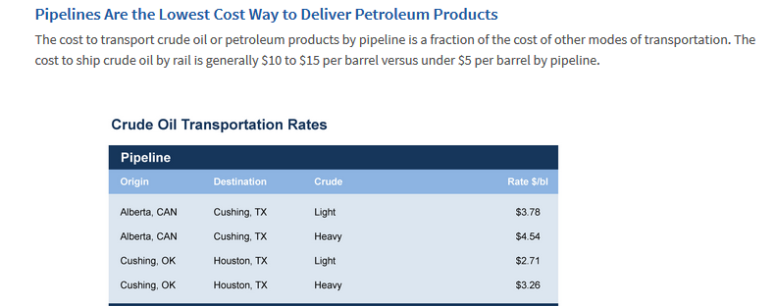By Staff
In North Dakota, we think, they’re stealth-building the next Alberta tar sands pipeline. Before you go saying “you’re spreading conspiracy theory,” let’s have a look at the economic reality of the Dakota Access Pipeline. Let’s “do the math.”
Here’s why we’re suspicious. The North Dakota pipeline is said to end up costing $4 billion for its construction. Let’s do the really crude, simple maths on this. Let’s assume shipping costs for Bakken crude oil will be $4.00 per barrel, see the chart below (the Dakota line is not mentioned because it’s not in place, so rates are unknown yet).
So, doing the simple minded man’s maths, just the construction costs won’t be met until the 1 billionth barrel of oil has been shipped. Then, add all the yearly pumping (energy) costs, wages and salaries for the pipeline company, interest on the debt, etc. etc. and very likely, the project wouldn’t break even until the 1.5 billionth barrel is shipped.

Source: Association of Oil Pipe Lines (AOPL)
Oops, that’s a problem. The way peak oil production almost always works (based on empirical data, not mathematical modeling) is that the peak production is reached when approx. 1/2 of the whole resource (“Estimated Ultimately Recoverable” oil) is used up. Since peak Bakken oil was approx. Sep-Dec 2014, there is only about 1.5-1.8 billion barrels left to recover there.
After that point, when oil is only sputtering out of the North Dakota field, the pipeline syndicate will be looking desperately to fill their pipes. Or go bankrupt.
They’re going to be looking north, to the Tar Sands of Alberta, for product to carry. We’re about 80% confident this is the actual (stealth) plan for this pipeline: another tar sands carrier. Activists should be scouting north of the present proposed loading terminal point to see if there’s any suspicious activity going on up to the Canadian border, I think. (Chart is from the Assoc. of Oil Pipe Lines, AOPL, website.
How big is the Bakken resource?
North Dakota’s oil field has been, for the past 5 years or so, producing approx. 1 million barrels of low-quality oil per day. How much oil is there?
” In April 2008, a USGS report estimated the amount of recoverable oil using technology readily available at the end of 2007 within the Bakken Formation at 3.0 to 4.3 billion barrels (680,000,000 m3), with a mean of 3.65 billion.[5]” (Wikipedia)
The production curve model done by Jean Laherrere shows the peak of Bakken production right at the 2014-2015 time cusp. Laherrere is a long-time collaborator with Association for the Study of Peak Oil and Gas, ASPO, based in Sweden. His Estimate of Ultimately Recoverable (EUR) is much higher than the Wikipedia entry cited earlier, but the end result is the same

So very crude maths, with 3,650-million barrels “ultimately recoverable”, pumping 1 million a day, you got 3,650 days of that production, America.
Call it ten years. Bakken oil field: Gone in ten years flat-out, maybe 20 years at the “sputtering” rate. What the hell they need that pipeline for, you ask yourself… is it a stealth line to the Alberta tar sands?
Mr. Obama and Ms. Clinton may say things about their energy policy that sound really stupid, to the educated person who studies energy issues. However, these leaders of the world’s lone superpower are quite smart operators. They pitch their policy at about a sophomore high-school level, while being aware at grad-school level what is really what about fracked oil fields. They know they’re going to have to turn increasingly to the world’s dirtiest, most carbon-emitting energy source, the Alberta Tar Sands.
Now, with a 400-mile reroute, you might picture the former KXL arriving in the USA right at the border of Sask, Manitoba, and NoDak. Go ahead, use your imagination.


